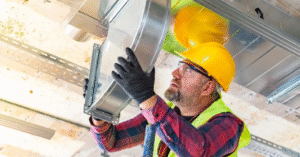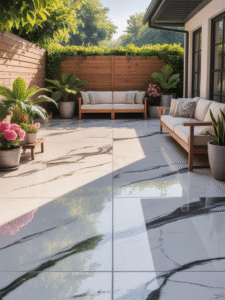Radon Mitigation Techniques in a Building
In this post I am going to discuss radon mitigation techniques in a building because it is a relatively new concern and the one in which techniques to deal with it are just emerging.
What is radon?
Radon is a colorless, odorless, tasteless gas found in soils and underground water.
An element with an atomic weight of 222, radon is produced in the natural decay of radium, and exists at varying levels throughout United States.
Radon is emitted from the ground to the outdoor air, where it is diluted to an insignificant level by the atmosphere.
Because \”radon is a gas\”, it can travel through the soil and into a building through cracks, joints, and other openings in the foundation floor and wall.
Earth-based building materials such as cast concrete, concrete masonry, brick, and adobe ordinarily are not significant sources of indoor radon.
Radon from well water sometimes do \”contributes\” in a minor way to radon levels in indoor air.
In a few cases, radon from well water has contributed significantly to elevated radon levels.
Health Risk of Radon Exposure
Radon is potentially harmful only if it is in the lungs when it decays into other isotopes (called radon progeny or radon daughters), and when these further decay.
The decay process releases small amount of ionizing radiation; this radiation is held responsible for the above-normal incidence of lung cancer found among miners.
Most of \”what\” is known about the risk of radon exposure is based on statistical analysis of lung cancers in humans (specially, underground miners) associated with exposure to radon.
This information is well documented internationally, although much less is known about the risk of long-term exposure to low concentrations of radon in buildings.
The lung cancer hazard due to radon is a function of the number of radioactive decay events that occur in the lungs. This is related to both intensity and duration of exposure to radon gas and decay products plus the equilibrium ratio.
Exposure to a low level of radon over a period of many years in one building can present the same health hazard as exposure to a higher level of radon for a shorter period of time in another building.
The sum of all exposures over the course of one\’s life determines the overall risk to that individual.
Strategies to Control Radon
As a national policy, the public has been urged by the Environmental Protection Agency to consider 4 p Ci/L (from long-term radon tests) as an “action level” for both new and existing buildings.
The ASHRAE Standard 62-1989, Ventilation for Acceptable Indoor Air Quality, has also recognized this value as a guideline.
In order to address the radon problem, it is necessary to find out to
What degree it is present on the site?
Then, depending on the level of concern, various techniques to control radon levels can be applied.
Generally there are three approaches:
- The barrier approach
- Soil gas interception
- Indoor air management
The \”barrier approach\” refers to a set of techniques for constructing a tight building foundation in order to prevent soil gas from entering.
Since the barrier approach differs for each foundation type, these techniques apply to basements, crawl spaces, and slab-on-grade foundations.
Intercepting soil gas refers to using vent pipes and fans to draw soil gas from a gravel layer beneath the foundation floor slab.This approach can be utilized for basements and slab-on-grade foundations.
The third general approach applies to all foundation types i.e. managing indoor air.
Managing Indoor Air for Radon Mitigation
Air management techniques may be used to minimize the suction applied to the surrounding soil gas by the building. To control the pressure differential across the envelope, it is desirable to make the entire building envelope airtight and control the amount of incoming fresh air, exhausted inside air, and supply air for combustion devices.
A passive house with no mechanical fans operating at any given condition has a neutral pressure plane where no pressure differential exists across the building envelope. Envelope cracks above this plane ex-filtrate and openings below infiltrate.

The principles applied to minimize pressure differences across the building foundation envelope are essentially the same as those recommended for moisture vapor control and energy-efficient design. These include the following:-
- Reduce air infiltration from the unconditioned spaces (crawl spaces, attics, and unconditioned basements) into the occupied space by sealing openings and cracks between the two, including flues, vent stacks, attic hatchways, plumbing, wiring, and duct openings.
- Consider locating the attic access outside conditioned space (for example, an attached garage).
- Seal all openings in top and bottom plates of frame construction, including interior partitions.
- Provide separate outdoor air intakes for combustion equipment.
- Install an air barrier in all above-grade exterior walls.
- Adjust ventilation systems to help neutralize imbalances between indoor and outdoor air pressures. Keeping a house under continuous slight positive pressure is a difficult technique to accomplish. At this time whole house, basement, or crawl space pressurization does not appear to be a viable solution to radon control.
- Do not locate return air ducts in a crawl space or beneath a slab. Placing the HVAC ducting inside the conditioned space will save energy as well.
- Do not locate supply ducts below concrete slabs on or below grade.
- Seal all return ductwork located in crawl spaces.
- Balance the HVAC ducts. System imbalance can lead to pressurization in some zones and depressurization in others.
Barrier approach for Radon Mitigation
Construction techniques for minimizing radon infiltration into the basement are appropriate where there is a reasonable probability that radon may be present. To determine this, contact the state health department or environmental protection office.
General approaches to minimizing radon include
(1) sealing joints, cracks, and penetrations in the foundation,
(2) evacuating soil gas surrounding the basement.
- Use solid pipes for floor discharge drains to daylight, or mechanical traps that discharge to subsurface drains.
- Use a 6-mil (minimum) polyethylene film beneath the slab on top of the gravel drainage bed. This film serves as a radon and moisture retarder and also prevents concrete from infiltrating the aggregate base under the slab as it is cast. Slit an “x” in the polyethylene membrane to receive penetrations. Turn up the tabs and tape them. Care should be taken to avoid unintentionally puncturing the barrier; consider using rounded riverbed gravel if possible. The riverbed gravel allows for freer movement of the soil gas and also offers no sharp edges to penetrate the polyethylene. The edges of the film should be lapped at least 12 inches. The polyethylene should extend over the top of the footing, or be sealed to the foundation wall. A 2-inch-thick sand layer on top of the polyethylene improves concrete curing and offers some protection from puncture of the polyethylene during the concrete pouring operation.
- Tool the joint between the wall and slab floor and seal with polyurethane caulk, which adheres well to concrete and is longlasting.
- Avoid perimeter gutters around the slab that provide a direct opening to the soil beneath the slab.
- Minimize shrinkage cracking by keeping the water content of the concrete as low as possible. If necessary, use plasticizers, not water, to increase workability.
- Reinforce the slab with wire mesh or fibers to reduce shrinkage cracking, especially near the inside corner of “L” shaped slabs.
- Where used, finish control joints with a 1/2-inch depression and fully fill this recess with polyurethane or similar caulk.
- Minimize the number of pours to avoid cold joints. Begin curing the concrete immediately after the pour, according to recommendations of the American Concrete Institute (1980; 1983). At least three days are required at 70 F, and longer at lower temperatures. Use an impervious cover sheet or wetted burlap to facilitate curing. The National Ready Mix Concrete Association suggests a pigmented curing compound should also be used. O
- Form a gap of at least 1/2-inch width around all plumbing and utility lead-ins through the slab to a depth of at least 1/2 inch. Fill with polyurethane or similar
- Do not install sumps within basements in radon-prone areas unless absolutely necessary. Where used, cover the sump pit with a sealed lid and vent to the outdoors. Use submersible pumps.
- Install mechanical traps at all necessary floor drains discharging through the gravel beneath the slab.
- Place HVAC condensate drains so that they drain to daylight outside of the building envelope. Condensate drains that connect to dry wells or other soil may become direct paths for soil gas, and can be a major entry point for radon.
- Seal openings around water closets, tub traps, and other plumbing fixtures (consider non shrinkable grout).
Sealing the Basement Walls
- Reinforce walls and footings to minimize shrinkage cracking and cracking due to uneven settlement.
- To retard movement of radon through hollow core masonry walls, the top and bottom courses of hollow masonry walls should be solid block, or filled solid. If the top side of the bottom course is below the level of the slab, the course of block at the intersection of the bottom of the slab should be filled. Where a brick veneer or other masonry ledge is installed, the course immediately below that ledge should also be solid block.
- Parge and seal the exterior face of below-grade concrete masonry walls in contact with the soil. Install drainage boards to provide an airway for soil gas to reach the surface outside the wall rather than being drawn through the wall.
- Install a continuous damp proofing or waterproofing membrane on the exterior of the wall. Six-mil polyethylene placed on the exterior of the basement wall surface will retard radon entry through wall cracks.
- Seal around plumbing and other utility and service penetrations through the wall with polyurethane or similar caulking. Both the exterior and the interior of concrete masonry walls should be sealed at penetrations.
- Install airtight seals on doors and other openings between a basement and adjoining crawl space.
- Seal around ducts, plumbing, and other service connections between a basement and a crawl space.

Intercepting Soil Gas
At this time the best strategy for mitigating radon hazard seems to be to reduce stack effects by building a tight foundation in combination with a generally tight above-grade structure, and to make sure a radon collection system and, at the very least, provisions for a discharge system are an integral part of the initial construction. This acts as an insurance policy at modest cost.
Once the house is built, if radon levels are excessive, a passive discharge system can be connected and if further mitigation effort is needed, the system can be activated by installing an in-line duct fan (see Figure 2-6). Subslab depressurization has proven to be an effective technique for reducing radon concentrations to acceptable levels, even in homes with extremely high concentrations (Dudney 1988).
This technique lowers the pressure around the foundation envelope, causing the soil gas to be routed into a collection system, avoiding the inside spaces and discharging to the outdoors. This system could be installed in two phases. The first phase is the collection system located on the soil side of the foundation, which should be installed during construction. The collection system, which may consist of nothing more than 4 inches of gravel beneath the slab floor, can be installed at little or no additional cost in new construction.
The second phase is the discharge system, which could be installed later if necessary. A foundation with good subsurface drainage already has a collection system. The underslab gravel drainage layer can be used to collect soil gas. It should be at least 4 inches thick, and of clean aggregate no less than 1/2 inch in diameter.
Weep holes provided through the footing or gravel bed extending beyond the foundation wall will help assure good air communication between the foundation perimeter soil and the underside of the slab. The gravel should be covered with a 6-mil polyethylene radon and moisture retarder, which in turn could be covered with a 2-inch sand bed. A 3- or 4-inch diameter PVC 12-inch section of pipe should be inserted vertically into the subslab aggregate and capped at the top.
Stack pipes could also be installed horizontally through below-grade walls to the area beneath adjoining slabs. A single standpipe is adequate for typical house-size floors with a clean, coarse gravel layer. If necessary, the standpipe can be uncapped and connected to a vent pipe. The standpipe can also be added by drilling a 4-inch hole through the finished slab.
The standpipe should be positioned for easy routing to the roof through plumbing chases, interior walls, or closets. Note, however, that it is normally less costly to complete the vent stack routing through the roof during construction than to install or complete the vent stack after the building is finished.
Connecting the vent pipe initially without the fan provides a passive depressurization system which may be adequate in some cases and could be designed for easy modification to an active system if necessary.
A subslab depressurization system requires the floor slab to be nearly airtight so that collection efforts are not short-circuited by drawing excessive room air down through the slab and into the system. Cracks, slab penetrations, and control joints must be sealed.
Sump hole covers should be designed and installed to be airtight. Floor drains that discharge to the gravel beneath the slab should be avoided, but when used, should be fitted with a mechanical trap capable of providing an airtight seal. Another potential short circuit can occur if the subdrainage system has a gravity discharge to an underground outfall. This discharge line may need to be provided with a mechanical seal.
The subsurface drainage discharge line, if not run into a sealed sump, should be constructed with a solid-glued drainpipe that runs to daylight. The standpipe should be located on the opposite side from this drainage discharge. It is desirable to avoid dependence on a continuously operating fan. Ideally, a passive depressurization system should be installed, radon levels tested and, if necessary, the system activated by adding a fan. Active systems use quiet, in-line duct fans to draw gas from the soil.
The fan should be located in an accessible section of the stack so that any leaks from the positive pressure side of the fan are not in the living space. The fan should be oriented to prevent accumulation of condensed water in the fan housing. The stack should be routed up through the building and extend 2 to 4 feet above the roof. It can also be carried out through the band joist and up along the outside of wall, to a point at or above the eave line. The exhaust should be located away from doors and windows to avoid reentry of the soil gas into the above-grade space. A fan capable of maintaining 0.2 inch of water suction under installation conditions is adequate for serving subslab collection systems for most houses (Labs 1988).
This is often achieved with a 0.03 hp (25W), 160 cfm centrifugal fan (maximum capacity) capable of drawing up to 1 inch of water before stalling. Under field conditions of 0.2 inch of water, such a fan operates at about 80 cfm. It is possible to test the suction of the subslab system by drilling a small (1/4-inch) hole in an area of the slab remote from the collector pipe or suction point, and measuring the suction through the hole.
A suction of 5 Pascals is considered satisfactory. The hole must be sealed after the test. Active subslab depressurization does raise some long-term concerns which at this time are not fully understood. If the radon barrier techniques are not fully utilized along with the subslab depressurization, considerable indoor air could be discharged, resulting in a larger than expected energy penalty. System durability is of concern, particularly motor-driven components. This system is susceptible to owner interference.








